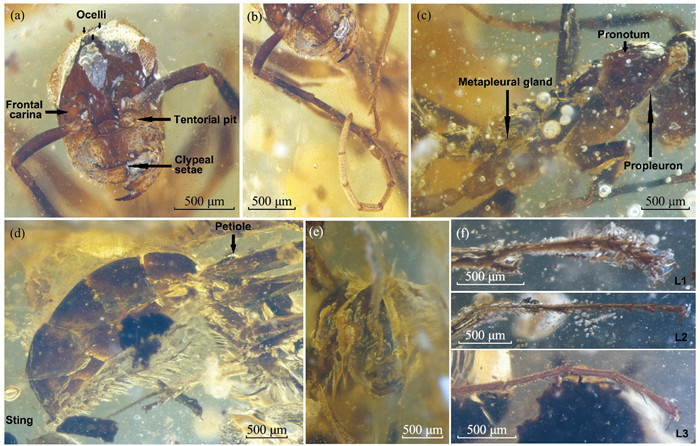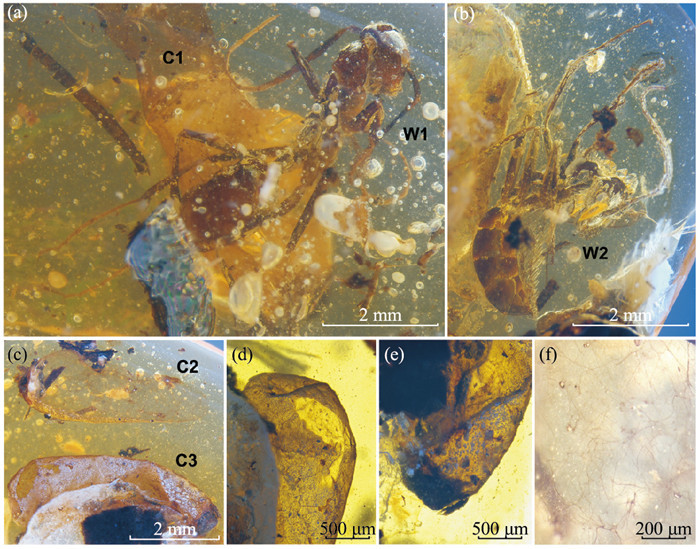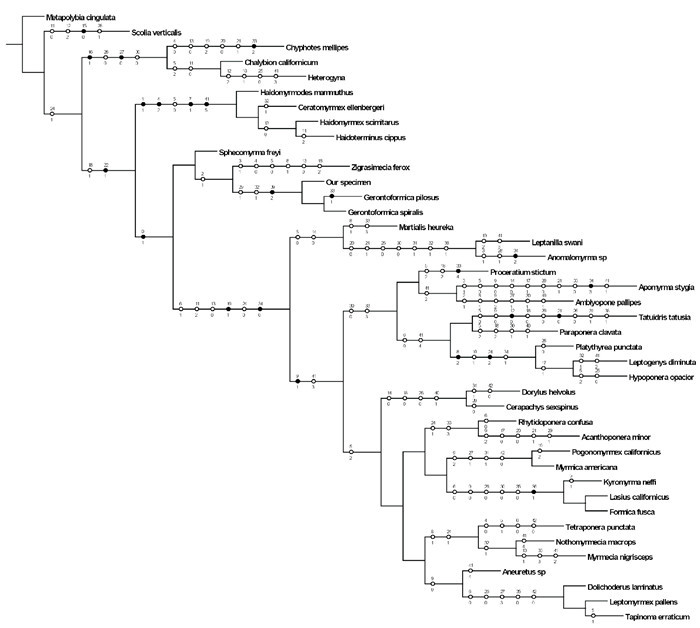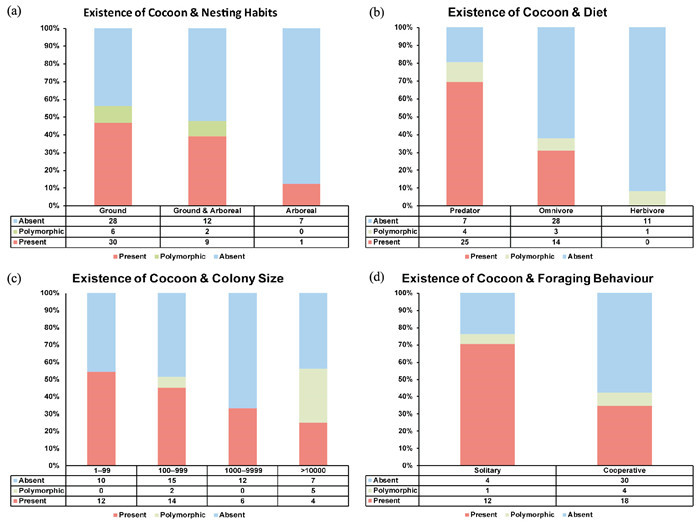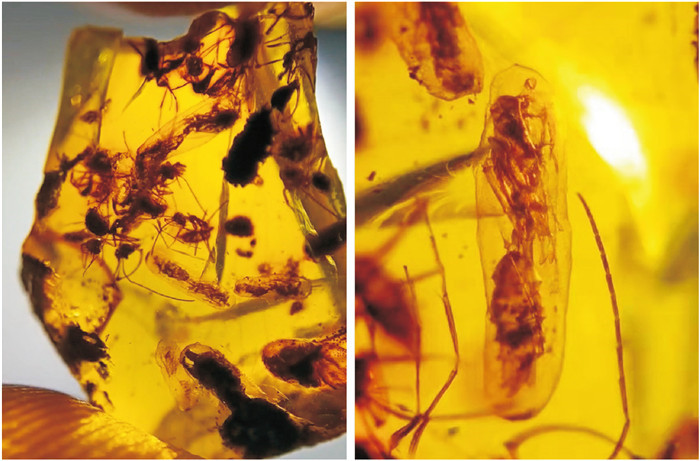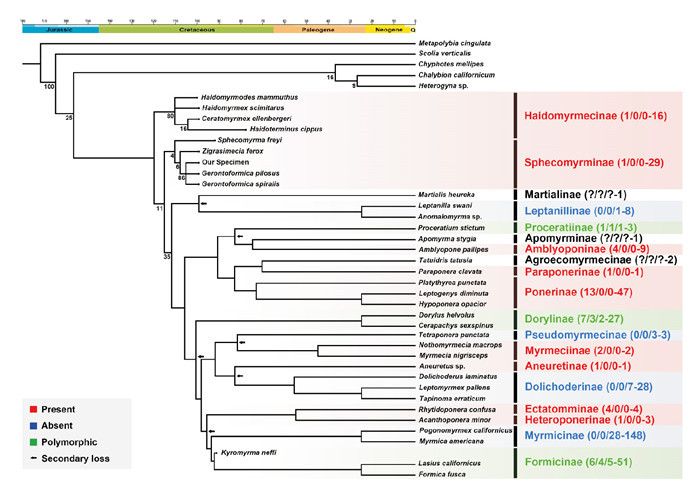
Phylogenetic tree of Formicidae, marked with presence and absence of pupal cocoons on the subfamily level.
Figures of the Article
-
![]() Photomicrographs of Gerontoformica sp. in the Myanmar amber specimen STJ-452 Holotype (Individual 1): (a) Frontal view of head features; (b) Frontal view of right antenna; (c) Dorsolateral view ofmesosoma. Paratype (Individual 2): (d) Lateralview of metasoma; (e) Frontal view of head features; (f) Details of left legs’ tarsus and claw.
Photomicrographs of Gerontoformica sp. in the Myanmar amber specimen STJ-452 Holotype (Individual 1): (a) Frontal view of head features; (b) Frontal view of right antenna; (c) Dorsolateral view ofmesosoma. Paratype (Individual 2): (d) Lateralview of metasoma; (e) Frontal view of head features; (f) Details of left legs’ tarsus and claw.
-
![]() Cretaceous worker ants and empty cocoons in the specimen STJ-452:(a) Ventral view of worker individual one (W1) and cocoon one (C1);(b) Lateral view of worker individual two (W2);(c) Photomicrograph of cocoon two (C2) and three (C3);(d) Front end of C3, showing the emergence hole under transmission light; (e) Tail end of C3, showing the meconium under transmission light; (f) Texture of the C2.
Cretaceous worker ants and empty cocoons in the specimen STJ-452:(a) Ventral view of worker individual one (W1) and cocoon one (C1);(b) Lateral view of worker individual two (W2);(c) Photomicrograph of cocoon two (C2) and three (C3);(d) Front end of C3, showing the emergence hole under transmission light; (e) Tail end of C3, showing the meconium under transmission light; (f) Texture of the C2.
-
![]() Cretaceous ant pupa in cocoon, preserved in specimen STJ-446:(a)Lateral view of the pupa; (b) Pygidium in detail, showing the sting and the third valvula; (c) Petiole in detail; (d) Texture of the cocoon.
Cretaceous ant pupa in cocoon, preserved in specimen STJ-446:(a)Lateral view of the pupa; (b) Pygidium in detail, showing the sting and the third valvula; (c) Petiole in detail; (d) Texture of the cocoon.
-
![]() Strict consensus tree yielded by Traditional Search (Equal-weight) in TNT v. 1.5.Unambiguous morphological character states are shown on the tree with a black circle as the homologous state and a white circle as the homoplasious state.
Strict consensus tree yielded by Traditional Search (Equal-weight) in TNT v. 1.5.Unambiguous morphological character states are shown on the tree with a black circle as the homologous state and a white circle as the homoplasious state.
-
![]() Phylogenetic tree of Formicidae, marked with presence and absence of pupal cocoons on the subfamily level.
Phylogenetic tree of Formicidae, marked with presence and absence of pupal cocoons on the subfamily level.
-
![]() Proportions of the genus with documented cocoon existence, showing the relationship between the existence of cocoons and four factors: (a) nesting habits, (b) diet, (c) colony size, and (d) foraging behavior. For data see Table 2.
Proportions of the genus with documented cocoon existence, showing the relationship between the existence of cocoons and four factors: (a) nesting habits, (b) diet, (c) colony size, and (d) foraging behavior. For data see Table 2.
-
![]() Ant cocoons produced by subfamily Haidomyrmecinae found in Myanmar amber (Pictures provided by the amber’s owner).
Ant cocoons produced by subfamily Haidomyrmecinae found in Myanmar amber (Pictures provided by the amber’s owner).


 Download:
Download:
